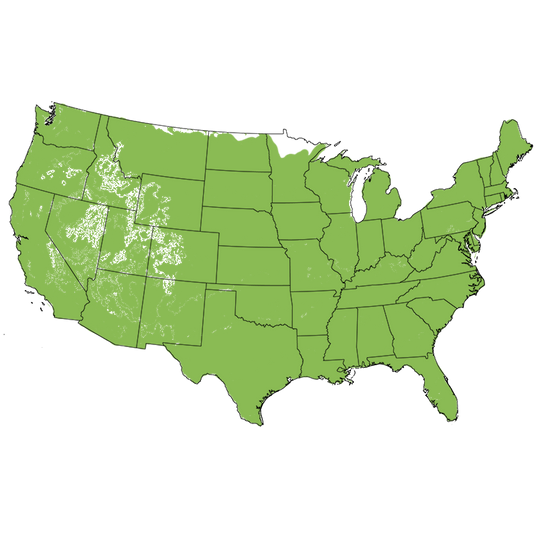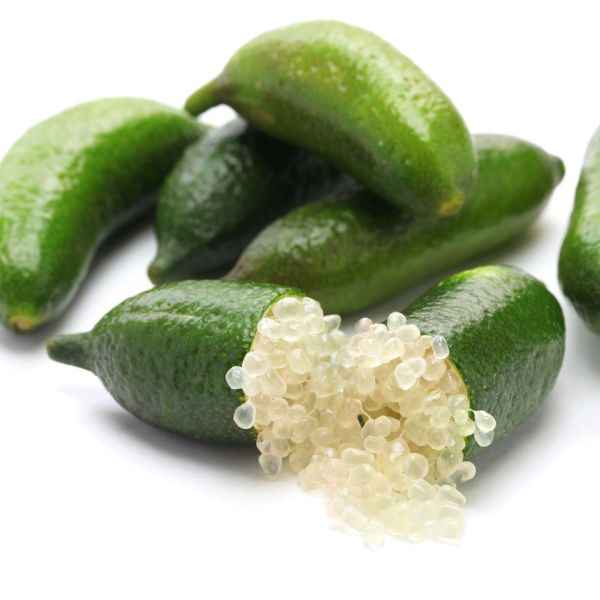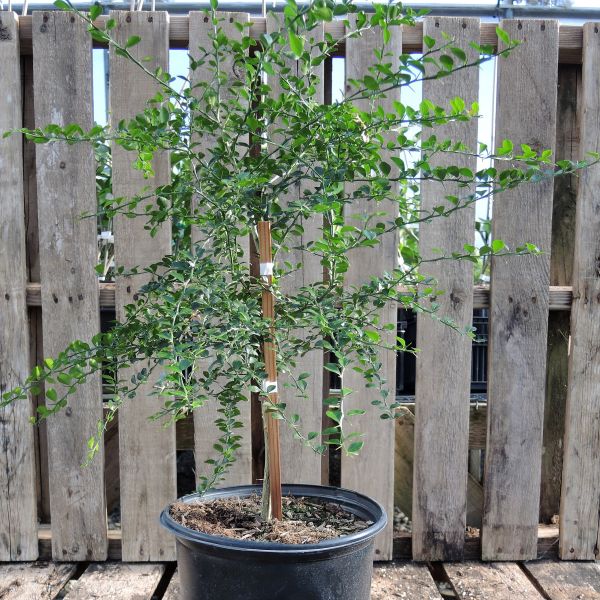Australian Finger Lime Tree
Citrus australasica
- Stay Protected with Plant Sentry ™
Australian Finger Lime Tree - #3 Container is backordered and will ship as soon as it is back in stock.
Plant Sentry™
Plant Sentry™

Plant Sentry™ Protected
Your order is protected by our compliance system that:
- Prevents restricted plants from shipping to your state
- Ensures plants meet your state's agricultural requirements
- Protects gardens from invasive pests and diseases
Delivery and Shipping
Delivery and Shipping
Delivery and Shipping
Fast, Safe Plant Delivery
Ships in 3-4 business days • Tracking provided • Weather protected
| Under $50 | $9.99 |
| $50 - $99.99 | $14.99 |
| $100 - $149.99 | $16.99 |
| $150 - $198.99 | $24.99 |
| $199+ | FREE |
✓ Zone-specific timing • ✓ Professional packaging • ✓ Health guarantee
Understanding Plant Options
Nature Hills offers plants in two main formats:
- Container Plants: Grown in pots with soil, sized by container volume and plant age
- Bare Root Plants: Dormant plants without soil, sized by height measurements
Container Plant Sizes
Container sizes indicate plant age and growing capacity rather than liquid volume equivalents. Our containers follow industry-standard nursery "trade gallon" specifications, which differ from standard liquid gallon measurements.
Young Plants (6 months to 18 months old)
| Container Size | Actual Volume | Metric Equivalent |
|---|---|---|
| 2" x 2" x 3" | 0.18 - 0.21 dry quarts | 0.20 - 0.23 dry liters |
| 4" Container | 0.31 - 0.87 dry quarts | 0.35 - 0.96 dry liters |
| 4.5" Container | 0.65 dry quarts | 0.72 dry liters |
| 6" Container | 1.4 dry quarts | 1.59 dry liters |
| 1 Quart | 1 dry quart | 1.1 dry liters |
| 5.5" Container | 1.89 dry quarts | 2.08 dry liters |
Established Plants (18 months to 2.5 years old)
| Container Size | Actual Volume | Metric Equivalent |
|---|---|---|
| 2 Quart | 2 dry quarts | 2.2 dry liters |
| #1 Container | 2.26 - 3.73 dry quarts | 2.49 - 4.11 dry liters |
| 5" x 5" x 12" | 3.5 - 4.3 dry quarts | 3.85 - 4.74 dry liters |
Mature Plants (2-4 years old)
| Container Size | Actual Volume | Metric Equivalent |
|---|---|---|
| #2 Container | 1.19 - 1.76 dry gallons | 5.24 - 7.75 dry liters |
| #3 Container | 2.15 - 2.76 dry gallons | 8.14 - 12.16 dry liters |
Large Plants (3-5 years old)
| Container Size | Actual Volume | Metric Equivalent |
|---|---|---|
| #5 Container | 2.92 - 4.62 dry gallons | 12.86 - 20.35 dry liters |
| #6 Container | 5.25 - 6.01 dry gallons | 23.12 - 26.42 dry liters |
| #7 Container | 5.98 - 6.53 dry gallons | 26.34 - 28.76 dry liters |
Bare Root Plants
Bare root plants are sold by height from the root system to the top of the plant. Plants may exceed minimum height requirements.
Common Sizes:
- Trees: 1 foot, 2 feet, 3 feet, 4 feet, 5 feet, 6 feet
- Shrubs & Perennials: 1 foot, 18 inches, 2 feet
Important Notes
Container Volume Specifications
- Trade Gallon Standard: Our containers follow industry-standard "trade gallon" specifications established by the American National Standards Institute (ANSI Z60.1) for nursery stock
- Volume Variations: Actual soil volume may vary due to plant root systems and growing medium settlement
- Age Indicators: Container size primarily indicates plant age and maturity rather than liquid volume equivalents
Growing Conditions
- Plant size can vary based on variety and growing conditions
- Container size helps indicate plant maturity and establishment level
- Larger containers generally mean more established root systems and faster landscape establishment
Seasonal Availability
- Bare root plants are available seasonally when dormant
- Container plants are available throughout the growing season
- Specific varieties may have limited availability in certain sizes
Questions?
For questions about specific plant sizes or availability, please contact our plant experts who can help you choose the right size for your landscape needs.
Plant Highlights
Australian Finger Lime Tree highlights at a glance!
-
Botanical Name
-
Brand
-
Growing Zones4, 5, 6, 7, 8, 9, 10, 11
-
Growth RateModerate
-
Mature Height
-
Mature Width
-
Leaf Color
-
Flower Color
-
Fall Color
-
Pollinator FriendlyYes
-
Pollinator Required
-
Bloom PeriodLate Spring, Early Summer, Late Summer
-
FragrantYes
Characteristics
Where To Plant
When To Prune
- Late Spring
Water & Moisture Needs
- Moderate
Sunlight Needs
Soil Needs
- Well Drained

Growing Zones
To say the Australian Caviar Finger Lime Tree (Citrus australasica) is not your typical Lime is an understatement. It looks nothing like a lime, in fact, some say it looks like a small pickle! Each fruit is a short, green cylinder shape that can be anywhere from 2 to 5 inches long.
Have you heard of Citrus caviar? The flesh of this Citrus-Lime variety isn't your standard, either. Instead, hundreds of round 'prills' literally spill out once the skin is cut into.
This unique fruit is where Australian Finger Lime gets its nickname, "the Caviar Lime." Each round little lime caviar 'prill' bursts in your mouth like a fine wine.
Enjoy how the intense lime flavor lingers on the back palate and lasts well into the next bite. Can you imagine the wonderful meals you'll season (and the yummy drinks you'll spritz) with these delicious little Lime pearls?
In addition to the wonderful taste, the small leaves and dainty flowers gave this plant a real ornamental appeal. Grow it as a shrub, a multi-trunk tree, or a single-trunked tree. This natural dwarf is a great indoor potted plant, as well.
Australian Caviar Finger Lime Tree is native to Australia and has only recently been discovered by the Citrus-loving masses worldwide. Although there are a number of different colors of Finger Limes such as yellow, pink, and red, only the green ones are currently available in the United States at this time.
Nature Hills is one of the few places where you can purchase this tree in the United States.
As you can imagine, these fabulous Citrus plants are in high demand. If it’s in stock, and you 'gotta have one', order it today! We will sell out fast!
How to Use Australian Finger Lime Fruit
Nothing about the Australian Caviar Finger Lime is expected. You don't slice these fruits, you cut them open to retrieve the caviar-like pulp inside.
Cooks love the Caviar Lime not just for its flavor, but because it reduces prep time, letting them get to the "good stuff" with a simple cut.
Bartenders around the world are the ones that are the most inspired by this incredible fruit, substituting it for the traditional Bearss or Mexican Lime or just creating exciting new drinks that are adorned with decorative prills floated on top or mixed in well to add quick bursts of lime flavor through the whole glass.
You'll find lots of culinary uses for the Australian Caviar Finger Lime. Use them to add zing to seafood entrees, from sushi to scallops and oysters.
Sprinkle the pulp of the Finger Lime on fruit or green salads or replace Citrus juice in your homemade vinaigrette or other salad dressing with lime pulp.
Top slices of cheesecake with a citrusy burst of pulp! You'll be proud to add prills from your very own Limes to a pitcher of mojitos to serve at your next get-together.
- Long Slender Green-Skinned 'Limes'
- Packed With Caviar-Like Prills
- Literally Bursts With Lime Flavor
- Versatile Culinary Delight!
- Evergreen Foliage, Fragrant Blooms & Gorgeous Year-Round Specimen Tree
#ProPlantTips for Care
If you live in a Zone where Citrus Trees thrive, then the Australian Caviar Finger Lime Tree is a good choice for growing in the ground on your property. If not, think about growing one in a container placed in a sunny window.
The Australian Finger Lime is one of the few Citrus or for that matter edible landscaping trees that can and needs to be grown in partial shade. Plant the Finger Lime where it gets plenty of morning sun and is entirely protected from the hot afternoon sun.
Traditionally grown as a bush or thicket, this is a great barrier plant as it does have thorns. Use this hard-working, valuable plant to protect your property in the right location.
The Australian Finger Lime is adapted to a wide range of soil and climates in Citrus-growing regions. Provide good drainage and regular water and increase the water during extreme heat periods. Citrus trees prefer acidic conditions and appreciate drying out slightly between waterings. Ensure container plants have adequate drainage holes and never sit in water for long. Set up a fertilizer routine to support your tree's growth.
Being an understory plant means it naturally grows beneath the canopies of tall Eucalyptus trees. The duff of the forest floor protects the plant's roots and provides nutrients. Provide a layer of mulch at least 3 to 4 inches deep and 3 to 4 feet beyond the outside of the canopy. This will help to keep the root system cool and nourished.
Protecting Container Citrus From Cold
The natural habitat of this Citrus variety would suggest it is a prime candidate for successfully growing and cropping in marginal Citrus areas. This is also true wherever Citrus trees are brought indoors during the wintertime.
If you're growing these tropical trees in the ground in the lowest of their favored growing zones, they need to be planted in a sheltered spot to avoid the worst of the chill. If a spot like that is unavailable then you are better off planting in a large, deep container.
In border-line growing zones, begin slowly acclimating your tree indoors or into a protected location, eventually moving your tree inside in bright indirect sun for the winter if the temperatures in your area ever dip below that 40°F range. In spring, reverse this process and begin acclimating your tree to again be back out in the full sun all summer. This reduces stress and leaf drop.
Place it in a sunny greenhouse or sunroom in full sun for best results over winter. Keep it on the dry side, and supplement with grow lights if needed to keep the tree bearing fruit.
- Full Sun For Best Results
- Sharply Drained Soil
- Moderate to Low Moisture Needs
- Acidic Soil & Acid-Loving Citrus Fertilizer
- Tolerates High Heat
Although this tree has small leaves and a delicate look, it's a tough-as-nails option in your landscape. We can practically guarantee that you will be one of the only houses on your block with this unique fruit tree.
Order one of these today and try this wonderful "new" fruit at your own kitchen table. Now available at Nature Hills Nursery!
Savored Since Ancient Times
The native Aboriginal tribes have consumed the Australian Finger Lime for thousands of years. But it's only in the last 100 or so years that they become of commercial interest, and only since the 1980's have they become popular.
The Finger Lime is native to Australia where it grows in the rainforest of Southeast Queensland and Northern New Wales, located on the eastern seaboard of Australia. The plant is known as an understory plant because it grows under the shade of the forest canopy.
Used for thousands of years by the native Aboriginal population for both food and medicine, the Finger Limes were not considered that important by the original European colonial settlers. Quite often plants were plowed under to make way for farming, with only a select number being saved for fruit production.
First described and named by noted Australian botanist Ferdinand von Mueller in 1858, he originally called the Finger Lime Citrus australasica, and made the first reference to its commercial potential. In 1913 another noted Australian botanist, Frederick Manson Bailey identified a red-fleshed selection that came true from seed in the wild and called it Citrus australasica var. sanquinea.
It is noted that in 1915 the most famous citrus scientist of the time, Walter T. Swingle; while working for the USDA in Washington, DC., reclassified the Australian Finger Lime as a Microcitrus.
This reclassification recognizes the significant difference with true Citrus, of which the most important differences are the very small leaves and flowers, and the elongated fruit of the Finger Lime. It is reported that Swingle worked with the Finger Limes while in Washington, but the program never went any further.
Although there has been attempts to reverse this name reclassification, to date this has not happened, and the debate continues. It is however important to note that both Citrus australasica and Microcitrus australasica are both recognized and used interchangeably.
In more recent times, steady interest has grown in the United States, though the first establishment of Finger Limes in the States did not occur until 1966, when Dr. Joe Furr of the USDCS in Indio, California, sent budwood to UC Riverside.
Primarily recognized by the chefs and bartenders at first, the Finger Lime has now become a regular recommendation for the home garden. This is additionally supported by the fact that it is one of the few edible plants that will tolerate a partial day of shade. More recent adaptations show that it takes well to pruning, making it easy to control its size and is well-adapted to being espaliered.
In the future, the consumer can look forward to the many differently colored varieties of Finger Limes including pink, red, orange, yellow and of course the green that is available today.










